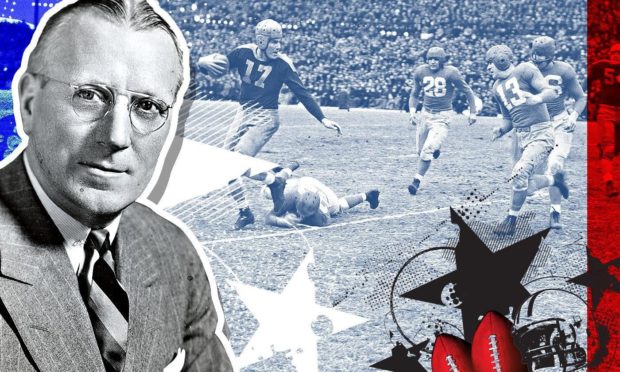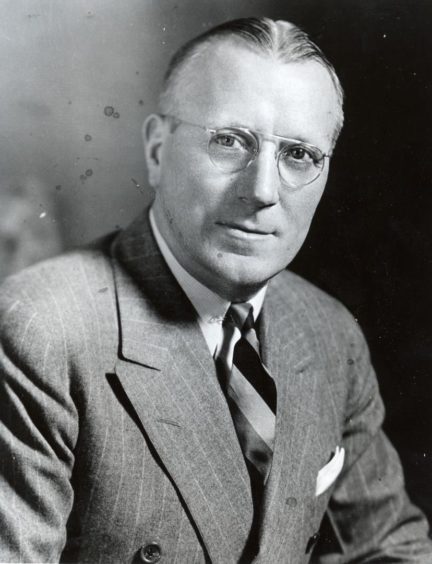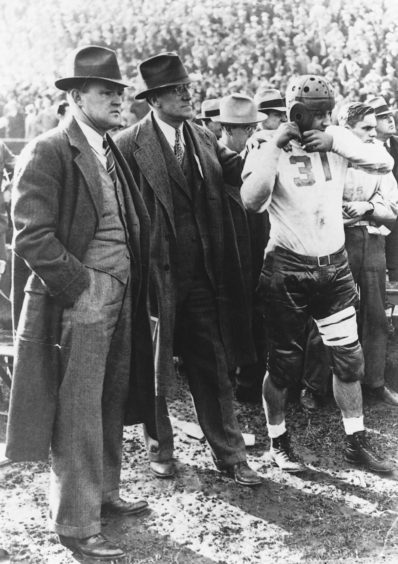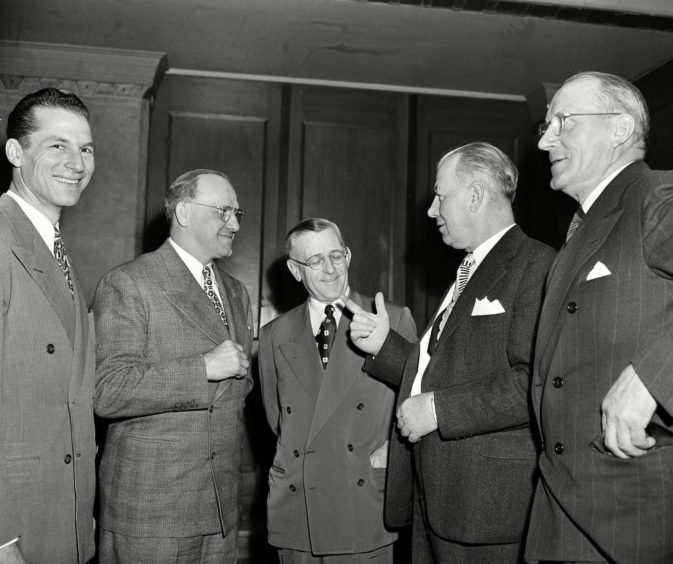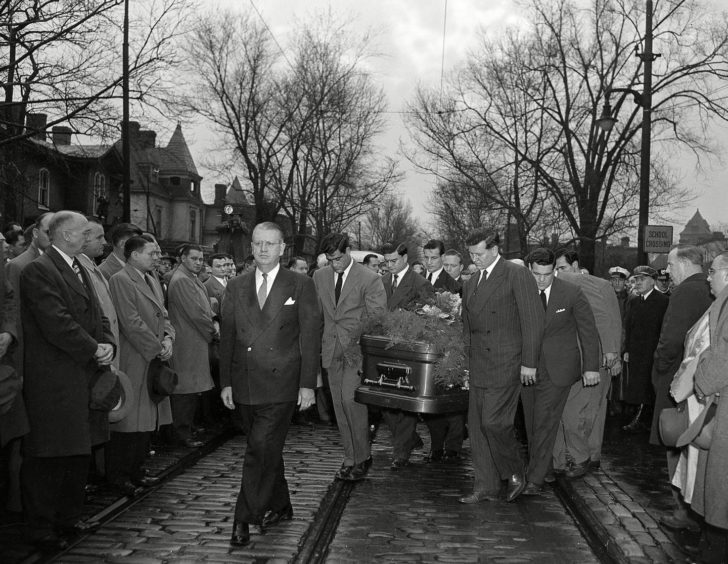Jock Sutherland escaped from a life of poverty in Coupar Angus to become one of the greatest American football coaches of all time.
Sutherland, a descendant of the poet Robert Burns, is a hero in Pittsburgh after a football coaching career that is almost unparalleled in modern times.
But his name is largely forgotten in Coupar Angus where he can stake a claim alongside football legend Alan Gilzean as the town’s greatest sporting export.
Who is Jock Sutherland?
Sutherland was born on March 21 1889 as one of seven children.
When his father, Archibald, suffered a fatal internal rupture trying to save the life of a fellow worker pinned under a fallen girder, mum Mary sent young Jock to America to join relatives there and escape from a life of poverty in Scotland.
He arrived in 1907 and settled in Sewickley, Pennsylvania, which is now a fashionable suburban sector on the outskirts of Pittsburgh.
After working his way through several prep schools, including one job as a night policeman, he entered Pitt’s School of Dentistry in 1914.
During his early years in America, Sutherland focused his sturdy, six foot four inch, 210-pound frame on soccer, the game most popular in his native Scotland.
But when Joe Duff, the Pitt football coach in 1914, got one look at this tall, strapping Scot, he convinced him to try his hand at football.
By the second game of the season, Sutherland became a starting guard.
He flourished at the game and he developed into one of the greatest guards in Pitt Panthers history.
He suffered defeat only once as a player, against Washington & Jefferson College in 1914, and won national championships in 1915 and 1916 under Pop Warner.
After receiving his degree as a Doctor of Dental Science in 1918, he joined the army and served overseas.
Upon discharge, in 1919, he moved to Lafayette College where he gave the Leopards of Lafayette their best football days in his five-year stay and won his first eight Eastern championships with his 1921 team and defeating Pitt twice in a row.
Taking charge in Pittsburgh
When Pop Warner left Pitt for Stanford after the 1923 season, Sutherland was asked to take his place and, at the same time, fill a position in the dental school faculty.
Sutherland came back to give Pitt the type of football that made it second to none in the country.
His first season was a tough but he made a notable comeback the following year and under his leadership he compiled a record of 111 wins, 20 losses, and 12 ties.
Sutherland was a stern taskmaster.
He managed to keep his players at a high level all season by coaching them in a calm, professional manner.
Joe Starkey from the Pittsburgh Post-Gazette said: “Sutherland was like a god.
“When it came to football, Pitt was it in these parts.
“The Steelers were still decades from staking their claim.”
The Sutherland-coached Panthers went undefeated four times; played in four Rose Bowls; and won national championships in 1929, 1931, 1934, 1936, and 1937.
The Panthers fielded 21 All-American players and future College Football Hall of Famers, including Marshall Goldberg, Joe Donchess, Averell Daniel, and many others.
“I have a deep affection for the University of Pittsburgh,” Sutherland once said.
“It is my university.
“I am proud to be a Pitt man.”
Built his mum a home in Scotland
Known as ‘The Great Stone Face’ or ‘The Dour Scot’, Sutherland enjoyed a drink of Scotch now and then.
He loved his mother and built her a home in Scotland after becoming successful.
Towards the end of his time at Pitt, Sutherland found himself at odds with the university’s administrators, including Chancellor John Gabbert Bowman, who wanted to lessen the focus on athletics.
As a result, a new set of guidelines for athletics was developed which stated, among other things, that the school would not recruit students to play sports.
In March 1939 Sutherland announced he had asked the University of Pittsburgh to accept his resignation as head football coach “effective at once”.
He left his post with a lifetime collegiate coaching record of 144 wins against 28 losses and 14 ties.
The University of Pittsburgh still has a letter sent from a young boy who threatened to jump off a building downtown if Sutherland did not return to his post.
Coaching in the NFL
Following his resignation at Pitt, Sutherland was out of football for a year before he became the first “name” coach to switch from the college to professional ranks by signing a contract with the Brooklyn Dodgers of the NFL.
He stayed for two seasons and both times he missed winning the Eastern Pro title by a single contest.
He left the Dodgers to join the Navy during World War Two, despite being 53 at the time.
After the war he was lured back to the town he loved and signed a contract to coach the Pittsburgh Steelers in the NFL.
Tim Rooney, son of Steelers founder Art Rooney, said Sutherland’s nickname was ‘Jock’ but nobody had the nerve to say ‘Jock’ in front of him.
“It was always ‘Doctor’ Sutherland,” he said.
“Everyone was in awe of him.
“The University of Pittsburgh was talked about the way Catholics talked about the Vatican.”
Sutherland didn’t need to raise his voice with his players, because he was such a regal and intimidating figure.
He took them to their first play-off berth in 1947 before he became sick a year later during a scouting trip for the Steelers.
Sutherland was found in his car in Bandana, Kentucky, where he was experiencing confusion and was then taken to a hospital in Cairo, Illinois, where he was initially diagnosed with “nervous exhaustion”.
He was flown back to Pittsburgh for further treatment.
An exploratory surgery was required to determine whether he was suffering from a haemorrhage or a tumour.
Sutherland died four days later on April 11 1948, following surgery to remove a malignant brain tumour.
“Jock, above all, was a leader,” said the Pittsburgh Post-Gazette in an editorial upon his death.
“This impressed you at once on first meeting him.
“Character, restraint and sincerity were written in his bearing.
“There is nothing anybody can say about the passing of Jock Sutherland that isn’t felt in the heart of every man and woman in Pittsburgh.
“In any list of the district’s assets, he was close to the top.’’
Sutherland was elected to the College Football Hall of Fame in 1951.
Pitt’s Sutherland Hall student housing facility and nearby Sutherland Drive were named after him.
Sutherland is a Pittsburgh legend and is buried at Homewood Cemetery among Pittsburgh dignitaries such as Frick, Mellon and Heinz.
Grave restoration
Carson Long, place-kicker for Pitt’s national championship team of 1976, became “fascinated” with college coaches from the first half of the 20th century.
Long knew of Sutherland, of course but he wanted to know more.
He read articles and books and went to visit Sutherland’s gravesite.
Tears came to his eyes when he saw the grass wasn’t mowed and there was mould all over the stone.
He started the Sutherland Restoration Fund after taking photos of the site and showing them to some of his old teammates.
They managed to raise just under $10,000 and restored the site.
Sutherland’s stone is connected to one bearing the name of his sister, Marion Burns Sutherland.
The University of Pittsburgh described Sutherland as “Pitt football’s all-time crown jewel” who “set impeccable standards of excellence” and “became a larger-than-life figure not only at Pitt but throughout the college football world”.
Grantland Rice, one of the greatest sportswriters from the golden age of newspapers, described Sutherland as “Scotland’s greatest football son”.
